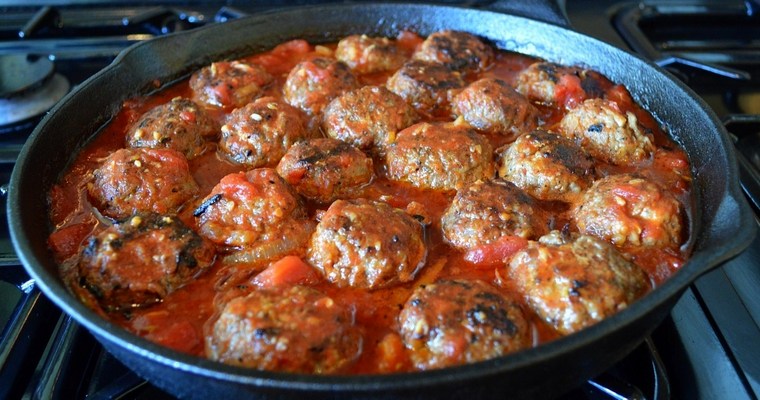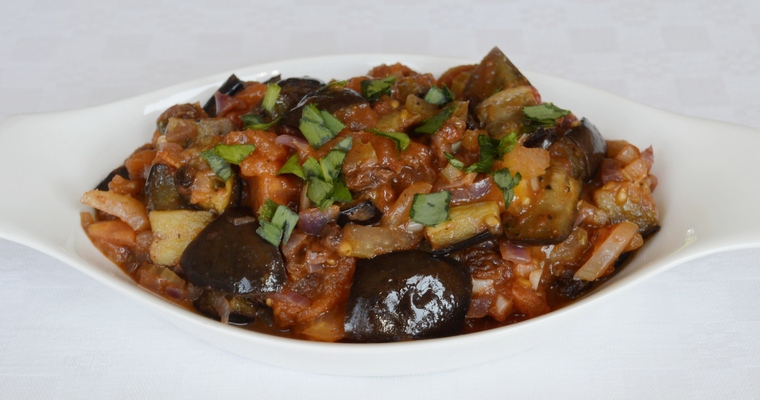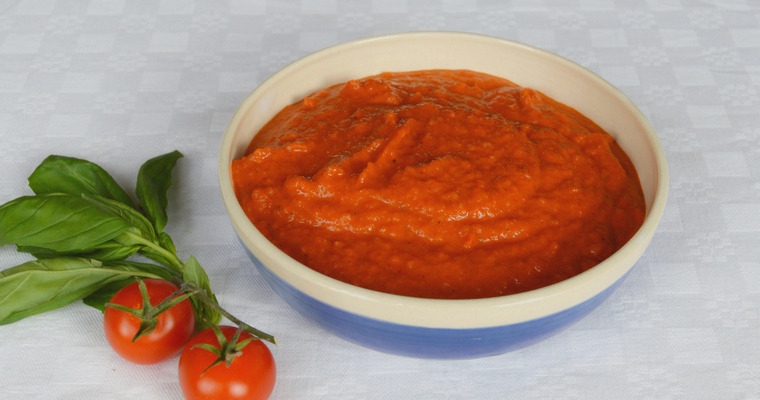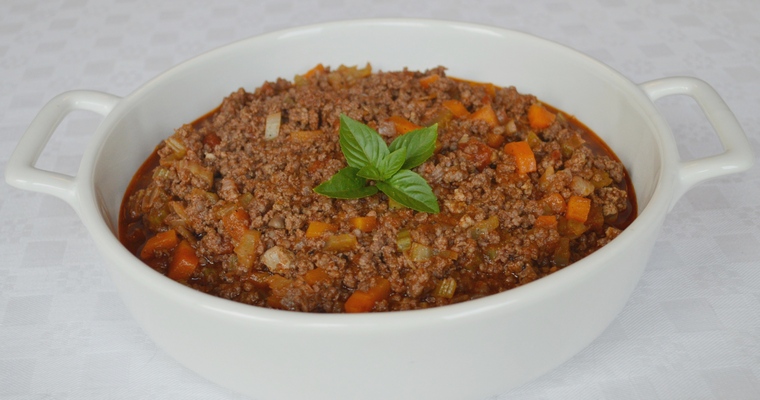Perfectly tender and juicy meatballs, cooked in a full and flavoursome tomato sauce. This Gluten-free, Dairy-free and Paleo recipe does not use breadcrumbs.
| Skip straight to the recipe |
01. What are meatballs?
Meatballs are found in various forms across Europe, Scandinavia, the Middle East and into Asia. If you haven’t dredged a fragrant Vietnamese broth for bobbing nuggets of pork, you may have tried Danish frikadeller, Turkish kofta, or come across Swedish meatballs the last time you bought flat-pack furniture. Regardless of regional variety, meatballs are a simple dish made by mixing ground meat with herbs and seasoning, then shaping into balls and cooking.
02. What meat should I use for meatballs?
Meatballs can be made from ground beef, lamb, veal, pork, or even poultry like chicken or turkey. They have the best flavour and texture when a combination of lean and fatty meats are used. A good lean-to-fat ratio is around 50:50, so a mix of 50% beef and 50% pork works well. Ground pork and lamb have a high fat content, which will render out during cooking. If too much fat is lost, the finished meatballs will become dry and crumbly, which will impact on the flavour and texture. You can prevent this by working the raw mixture for a few minutes, using your hands to knead the mixture. This creates an emulsion by suspending the fat particles in the meat proteins. When the fat particles are surrounded by protein they will hold together, and the fat will remain inside the meatball.
03. Why do most meatball recipes contain breadcrumbs?
Many recipes include a couple of slices of soft white bread, minus the crusts. The bread is torn into pieces and left to soak for 10 minutes in about 6-8 tablespoons of milk – or however long is sufficient to create a thick paste when mashed with the back of a fork. This is called a ‘panade’, which refers to a liquid-and-starch paste that is used in cooking to thicken sauces or bind ingredients together. In ground meat dishes, a panade also keeps the meat tender and moist by absorbing the meat juices that are released during cooking. If you’re cooking ground meat for a long time in the oven (like my American Meatloaf or Faggots recipes), then some sort of panade is essential to stop the meat from drying out. Meatballs, however, are cooked for a much shorter period of time, so a panade is not strictly necessary, although it does result in a lighter and softer texture. As an experiment, I made a batch of meatballs with a panade made from gluten-free bread and almond milk. They had a texture similar to an English breakfast sausage, and my husband and I both decided that we preferred the more substantial texture and meatier flavour of the pure meat version. So provided you do not use a lean meat or chunky ingredients, and work the raw mixture well, you will not need to add a binding agent or moistener like the lightly beaten egg which so many recipes suggest.
04. What other ingredients can I add to meatballs to increase moistness?
One way of adding more moisture to meatballs is to include raw grated onion. However, grating breaks more of the onion cells, which releases stronger flavour compounds. I have found that meatballs made with raw grated onion can be too astringent, because the onion is not cooked long enough to neutralise the bitter sulphur flavour. Raw onions and garlic should not be put directly into the mix, but should be sauteed first. The onion needs to be very finely chopped, as coarsely-chopped ingredients will cause your meatballs to fall apart. By the same token, you can add raw vegetables such as courgettes or butternut squash, provided they are finely grated, or cooked and pureed.
05. How do I cook meatballs?
The cooking method for meatballs differs according to whether the meatballs are served dry or dressed in a sauce. Meatballs that are served dry and undressed, such as kofta, are cooked using a direct heat method, such as a grill, frying pan or baking in the oven. This creates a tasty brown crust, as the meat sugars caramelise on the surface of the meatball. Meatballs that are served in a sauce are usually cooked in the same pan as the sauce. This is mutually beneficial to both parts of the dish, as the meatballs are tender and juicy thanks to the gentle poaching method of cooking, while the flavour of the sauce is enhanced by the meat juices. In order to achieve a tasty caramelised crust, the meatballs should be quickly browned in a frying pan before being poached.
Tips & Tricks
- Chop ingredients very finely (or grate or puree) – coarse ingredients result in crumbly meatballs that fall apart
- Mix by hand – food processors are too aggressive and ruin the texture of ground meat
- Work the raw mixture – this develops the meat proteins so that the meatballs hold together better and retain the fat
- After forming meatballs, refrigerate for at least 30 minutes – this firms up the texture
- When frying, heat the pan to sizzling point – this creates an instant seal when the meat is added, preventing it from sticking and keeping the moisture locked in
- Do not overcrowd the pan – this will cause the meatballs to stew in their own juices rather than brown
- Do not turn for the first minute, until the cooking side has formed a seal – otherwise the bottom will stick to the pan and break apart
Ingredients
for the meatballs:
- 3 tablespoons cooking oil (I used lard)
- 1/2 onion (65g), peeled and very finely chopped
- 2 garlic cloves, peeled and minced
- 250g tart apples, peeled, cored and finely grated
- 1 tablespoon finely chopped fresh sage leaves
- 1 teaspoon salt
- 1/2 teaspoon freshly ground black pepper
- 700g mince (400g pork, 300g beef)
for the tomato sauce:
- 1 tablespoon cooking oil (I used lard)
- 1 1/2 onions (195g), peeled and coarsely chopped
- 2 cloves garlic, peeled and minced
- 1 teaspoon fennel seeds
- 2 tablespoons tomato purée
- 2 bay leaves
- 1/2 teaspoon salt
- 1/4 teaspoon freshly ground black pepper
- 400g (1 can) tinned chopped tomatoes
- 1 cup (240ml) homemade stock (I used chicken stock)
- 1 teaspoon honey (if needed)
Instructions
- Saute the onion and garlic. Heat 1 tablespoon of the cooking oil in a large, heavy-based frying pan over a medium heat. Add the onion and fry for about 4 minutes, until translucent but not brown. Add the garlic and fry for another minute. Turn off the heat and leave to cool to room temperature.
- Prepare the meatballs. Once the onion mixture has cooled, transfer to a large mixing bowl. Add the remaining meatball ingredients except for the mince (apple, sage, salt and pepper). Mix well using a wooden spoon. Use your hands to crumble in the mince. Still using your hands, mix everything together until well blended, breaking up the mince and working in the seasoning. Keep kneading the mixture for a few minutes, until it holds together well.
- Shape the mixture into 20 equal-sized balls by rolling between the palms of your hands. If they are too crumbly, then work the mixture some more. Place the balls on a tray, and refrigerate for at least 30 minutes to firm up.
- Cook the tomato sauce. Meanwhile, make the tomato sauce. Heat the cooking oil in a large, shallow pan for which you have a lid over a medium heat. Add the onion and fry for 8 minutes, stirring occasionally, until translucent but not brown. Add the garlic and fennel seeds, and fry for another minute.
- Add the remaining ingredients (tomato purée, bay leaves, salt, pepper, tinned tomatoes and stock) and stir to mix well. Bring the sauce to the boil, then reduce the heat to a simmer and cook for 20 minutes. Taste, and adjust the seasoning if necessary, adding a teaspoon of honey if the sauce is too acidic. Turn off the heat and cover with a lid to keep warm.
- Brown the meatballs. By now, your meatballs should be firmed up. Heat 2 tablespoons of the cooking oil in a large, heavy-based frying pan over a medium-high heat (you can use the same pan in which you sauteed the onion and garlic for the meatballs). When a few drops of water sizzle and evaporate upon contact with the pan, add the meatballs. Sear the meatballs in 3-4 batches until browned all over with a caramelised crust – about 4 minutes a batch. Add more cooking oil if necessary. Do not overcrowd the pan, and do not turn during the first minute of frying. Transfer to a plate with a slotted spoon.
- Deglaze the pan. Pour off any excess cooking oil from the frying pan into a jam jar. Add 3 tablespoons of water. Once it starts to bubble, scrape off any browned bit from the bottom with a wooden spatula for 2-3 minutes. The liquid should turn a deep brown colour. Pour this flavoursome liquid into the tomato sauce.
- Cook the meatballs in the sauce. Once the meatballs are all browned, bring the tomato sauce to the boil. Reduce the heat to a simmer, then gently transfer the meatballs to the sauce. The meatballs should be part-submerged in liquid, not fully covered. More liquid will be released from the meatballs during cooking, so do not top up with more liquid. Cover with a lid, and cook for 20 minutes. Do not stir the sauce or turn the meatballs, as this may cause them to break apart.
- If, at the end of cooking, the sauce is too thin, then reduce it (a thin sauce will not cling to noodles, and will simply run off to pool at the bottom of the plate). Gently remove the meatballs from the pan using a slotted spoon, and keep warm by covering in tin foil. Turn the heat up to high and boil rapidly to reduce the cooking liquid to a thick sauce – about 5-10 minutes.
- Transfer the meatballs to a serving dish and spoon over the sauce. Alternatively, if serving with noodles, pour the sauce all over the noodles and toss until well coated. Serve in pasta bowls and top with the meatballs.
Accompaniments
Paleo
Vegetable ‘spaghetti’: allow 1 courgette per person. Trim the ends, and chop into thin strips using a spiraliser or a julienne peeler.
Gluten-free
Brown rice noodles: allow 70g per person. Leave to soak in just-boiled water for 10 minutes before draining.





